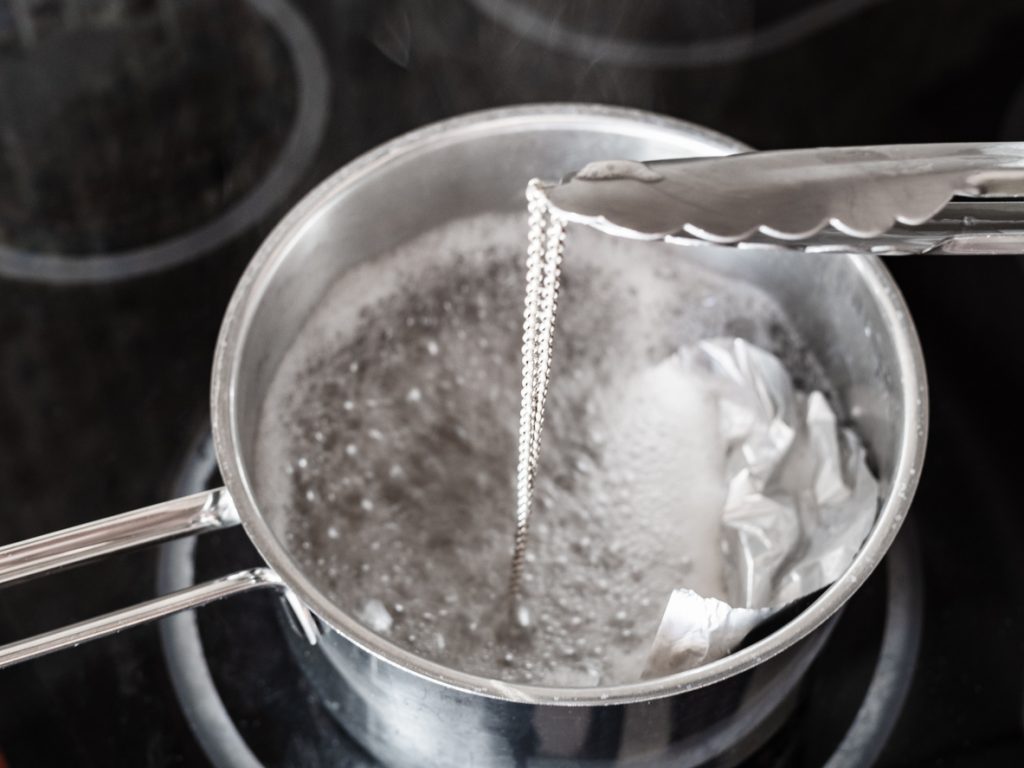Silver jewelry adds a touch of elegance to any outfit, but over time, it can lose its luster. The good news? You don’t need expensive cleaning products to restore its shine. I’ve tested countless methods over the years and found several effective techniques using items you likely already have at home. Let me share what I’ve learned about keeping these treasures looking their best.
Polishing Sterling Silver
Polishing is the most straightforward method for cleaning lightly tarnished silver. A microfiber cloth works wonders for this purpose, though specialized silver polishing cloths offer even better results. These cloths typically contain anti-tarnish agents that help slow future discoloration.
Start by washing your hands to remove oils that could transfer to the silver. Hold your jewelry by the edges to avoid fingerprints on freshly cleaned surfaces. Gently rub the silver in back-and-forth motions rather than in circular ones, which can create noticeable patterns if you polish too aggressively.
The Baking Soda and Aluminum Foil Cleaning Method

This method relies on a fascinating chemical reaction that transfers the tarnish from your silver to the aluminum. You’ll need aluminum foil, baking soda, salt, and hot water. The process is simple but feels like performing a science experiment in your kitchen.
Line a bowl with aluminum foil, shiny side up. Add one tablespoon of baking soda and one teaspoon of salt for each cup of hot water you use. The water should be hot but not boiling—around the temperature of coffee you’d comfortably drink. Place your silver pieces on the foil, ensuring they make contact with it.
Magic happens almost immediately. You’ll notice tiny bubbles forming as the chemical reaction begins. The sulfur atoms causing the tarnish are attracted to the aluminum, leaving your silver clean. Let your jewelry sit for 3-5 minutes for light tarnish or up to 10 minutes for heavier buildup.
After removing the pieces, rinse thoroughly under cool running water and pat dry with a soft cloth. I accidentally left a silver chain in this solution for nearly an hour once and it still emerged perfectly fine—this method is remarkably gentle despite its effectiveness.
The Mild Soap and Water Method to Clean Sterling Silver Jewelry
Gentler methods are essential for silver jewelry with gemstones or pearls. The soap-and-water approach provides a safe option for these more delicate pieces. Simple doesn’t mean ineffective—this method removes body oils and everyday grime that dulls silver’s appearance.
Choose a mild dish soap free from phosphates or bleach. Mix a few drops in a bowl of lukewarm water until you see slight suds forming. Submerge your silver pieces for about 2-3 minutes, then gently scrub with a soft-bristled toothbrush. Pay special attention to crevices where tarnish often accumulates.
Rinse your jewelry thoroughly afterward. Soap residue can cause a film that makes silver appear dull, so take your time with this step. After rinsing, I always pat my pieces with a soft towel and then allow them to air dry completely before storing.
This method works beautifully for my everyday silver rings, which collect lotion and soap residue rather than heavy tarnish. I’ve made it a habit to clean them this way every few weeks after noticing how much brighter they look afterward.
The White Vinegar and Baking Soda Method
For stubborn tarnishes that resist gentler methods, white vinegar combined with baking soda creates a powerful cleaning solution. The mild acid in the vinegar helps dissolve tarnish while baking soda provides gentle abrasion to lift stains without scratching.
Mix 1/2 cup white vinegar with 2 tablespoons of baking soda in a shallow bowl. The mixture will fizz initially—wait until it settles before proceeding. Soak your silver pieces for about 2-3 hours, checking periodically. The longer timeframe makes this method perfect for overnight cleaning when you’re not in a hurry.
After soaking, rinse your jewelry thoroughly under cold running water. Stubborn spots may require gentle scrubbing with a soft toothbrush. Pat dry with a clean cloth and allow to air dry completely before wearing or storing.
My mother swears by adding a tablespoon of salt to this mixture for extra cleaning power. I’ve tried it both ways and do notice faster results with salt added, especially for heavily tarnished pieces that have been neglected for years.
How do you make silver shiny again?
Beyond basic cleaning, achieving that mirror-like finish often requires an extra step. For special occasions, I use a technique learned from a jeweler friend. After cleaning with any of the above methods, rinse your silver thoroughly and allow it to dry almost completely.
Then, use a jewelry-polishing cloth specifically designed for silver. These cloths contain microscopic abrasives and polishing agents that bring out silver’s characteristic shine. Use gentle, straight strokes rather than circular motions for the most even finish.
For pieces with intricate details, a soft makeup brush can help apply a small amount of commercial silver polish to hard-to-reach areas. Just be sure to remove all residue afterward with a clean, damp cloth. Any polish left behind will cause faster tarnishing later.
The key to maintaining shine lies in proper storage. Keep silver in anti-tarnish bags or cloth pouches when not in use. Avoid storing different pieces together where they might scratch each other. I keep small silica gel packets (saved from product packaging) in my jewelry box to absorb moisture.
Will hydrogen peroxide damage sterling silver?

Many people wonder about using hydrogen peroxide to clean silver. While it can remove tarnish, I recommend caution. Hydrogen peroxide is safe for solid sterling silver in limited applications but can damage some gemstones and pearls.
If you decide to try hydrogen peroxide, dilute it with equal parts water and limit exposure to just a few minutes. Never soak silver with soft stones like turquoise or opals in hydrogen peroxide, as it may permanently alter their color or structure.
I once briefly soaked a silver and amethyst ring in hydrogen peroxide, and while the silver brightened beautifully, the stone lost some of its rich purple hue. That experience taught me to be more selective about which cleaning methods I use for different pieces.
Will Dawn dish soap clean sterling silver?
Dawn and other mild dish soaps make excellent cleaners for silver jewelry. These soaps effectively remove oils, makeup residue, and light tarnish without harsh chemicals. The gentle formulation makes them particularly suitable for pieces with gemstones.
Create a solution with a few drops of dish soap in warm water. Soak your silver for 5-10 minutes, then clean it with a soft brush if needed. Rinse thoroughly to remove all soap residue, as any remaining soap can leave a film that dulls the appearance of your jewelry.
I keep a small designated bowl and toothbrush specifically for cleaning my silver collection. Having these tools ready makes the process so much simpler that I’m more likely to clean my pieces regularly, which prevents heavy tarnish from developing.
What is the best homemade jewelry cleaner for silver?
Among all the homemade cleaning solutions I’ve tried, the aluminum foil and baking soda method delivers the most impressive results with minimal effort. The reaction literally pulls the tarnish away from the silver rather than just scrubbing it off the surface.
For everyday maintenance, though, the mild soap and water method provides the perfect balance of effectiveness and gentleness. It’s safe for most gemstones and removes the daily buildup that prevents silver from looking its best.
My personal cleaning routine combines methods based on how tarnished pieces are. For regular maintenance, I use soap and water. For seasonal deep cleaning, I use the aluminum foil method. This approach has kept my silver collection looking beautiful for years.
Conclusion
Proper cleaning extends the life and beauty of your silver jewelry. Each method has its place depending on the type of silver, degree of tarnish, and presence of gemstones. Regular maintenance prevents heavy tarnish buildup that requires more aggressive cleaning.
Remember that prevention is as important as cleaning. Store your pieces properly in anti-tarnish bags, keep them away from chemicals like chlorine and sulfur, and wipe them after wearing them to remove body oils. With these habits, your silver jewelry will maintain its beauty for generations.
ALSO READ: How to Transition to a Fall Vegan Skincare Routine
FAQs
Clean regularly worn pieces every 2-3 weeks and store jewelry every few months to prevent heavy tarnish buildup.
Use the mild soap method for pieces with stones, avoiding baking soda or vinegar methods, which may damage certain gemstones.
Humidity, air pollution, and sulfur compounds in the environment accelerate the tarnishing process.
For valuable antiques, consult a professional. Home methods may remove intentional patina that adds to the piece’s value.
Store in anti-tarnish bags, keep away from chemicals and perfumes and wipe pieces after wearing to remove skin oils.



